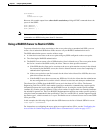
7-2
Cisco IOS Software Configuration Guide for Cisco Aironet Access Points
OL-29225-01
Chapter 7 Configuring Multiple SSIDs
Understanding Multiple SSIDs
Understanding Multiple SSIDs
The SSID is a unique identifier that wireless networking devices use to establish and maintain wireless
connectivity. Multiple access points on a network or sub-network can use the same SSIDs. SSIDs are
case sensitive and can contain up to 32 alphanumeric characters. Do not include spaces in your SSIDs.
You can configure up to 16 SSIDs on your access point and assign different configuration settings to
each SSID. All the SSIDs are active at the same time; that is, client devices can associate to the access
point using any of the SSIDs. These are the settings you can assign to each SSID:
• VLAN
• Client authentication method
Note For detailed information on client authentication types, see Chapter 11, “Configuring
Authentication Types.”
• Maximum number of client associations using the SSID
• RADIUS accounting for traffic using the SSID
• Guest mode
• Repeater mode, including authentication username and password
• Redirection of packets received from client devices
If you want the access point to allow associations from client devices that do not specify an SSID in their
configurations, you can set up a guest SSID. The access point includes the guest SSID in its beacon. If
the guest mode is disabled, the SSID will not be broadcast in the beacon messages. If you do not want
clients that do not have a preconfigured SSID to connect to the wireless network, disable the guest SSID
feature. For information on how to configure guest mode SSID and disable Guest mode SSID, see the
“Creating an SSID Globally” section on page 7-4.
If your access point will be a repeater or will be a root access point that acts as a parent for a repeater,
you can set up an SSID for use in repeater mode. You can assign an authentication username and
password to the repeater-mode SSID to allow the repeater to authenticate to your network like a client
device.
If your network uses VLANs, you can assign one SSID to a VLAN, and client devices using the SSID
are grouped in that VLAN.
Effect of Software Versions on SSIDs
Cisco introduced global-mode SSID configuration in Cisco IOS Release 12.3(2)JA to simplify
configuration of SSID parameters under multiple interfaces. Configuration of SSID parameters at the
interface level was supported in Cisco IOS Release 12.3(2)JA release for backward compatibility, but
configuration of SSID parameters at the interface level disabled in releases after Cisco IOS Release
12.3(4)JA. Table 7-1 lists the SSID configuration methods supported in Cisco IOS Releases.
Table 7-1 SSID Configuration Methods Supported in Cisco IOS Releases
Cisco IOS Release Supported SSID Configuration Method
12.2(15)JA Interface-level only
12.3(2)JA Both interface-level and global


















